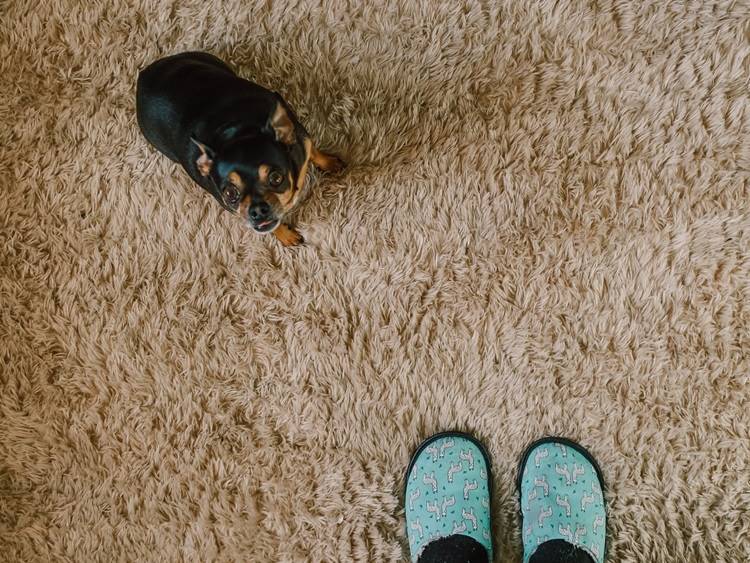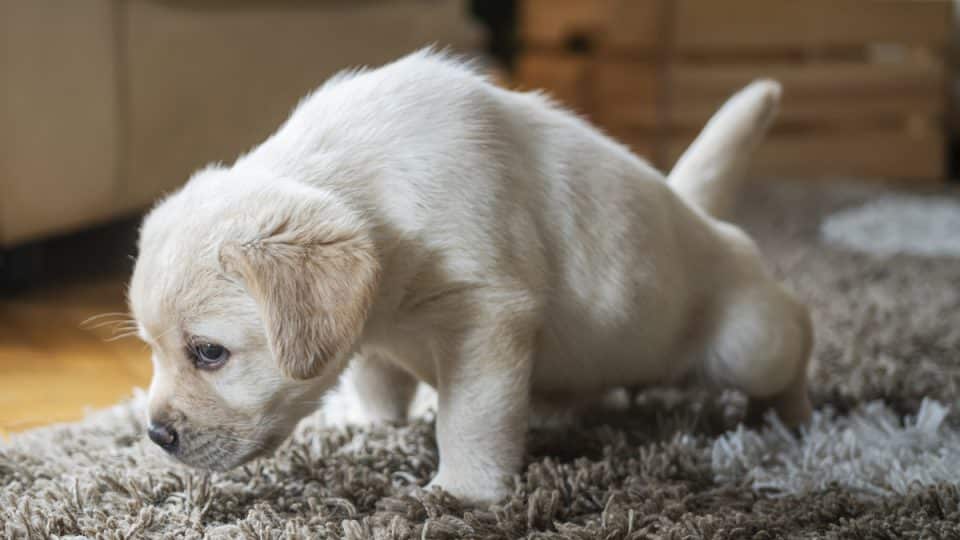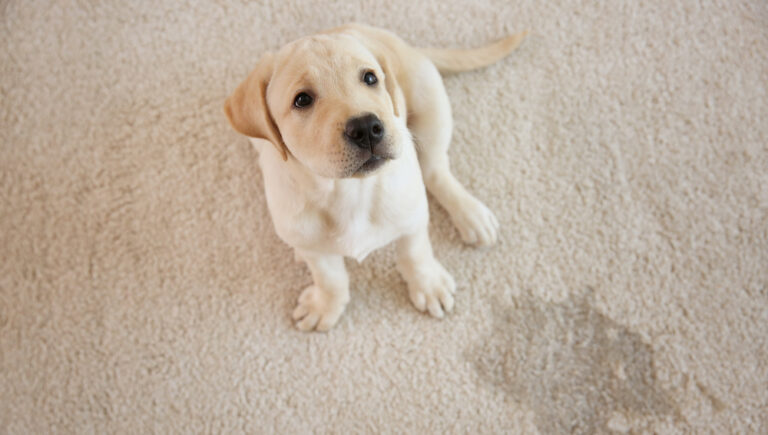To stop a dog from peeing on the carpet, establish a consistent routine for potty breaks and reward good behavior with treats and praise. Clean up accidents immediately with an enzymatic cleaner to remove odors and discourage repeat incidents.
Dealing with a dog that repeatedly pees on the carpet can be frustrating, but there are effective strategies to address this behavior and prevent future accidents. By implementing a structured potty schedule, providing positive reinforcement, and using appropriate cleaning products, you can effectively train your dog to avoid peeing on the carpet.
Understanding the reasons behind your dog’s behavior and taking proactive measures will help you tackle this issue and create a clean and hygienic environment for both your pet and your home.

Credit: www.stevescarpetcare.net
Understanding The Problem
Understanding the problem is essential when it comes to tackling a dog’s inappropriate urination on the carpet. To effectively address this issue, it is important to identify the cause and be aware of the common reasons for such behavior.
Please Your Response
To identify the cause of your dog’s inappropriate urination on the carpet, observe their behavior and consider any recent changes in their environment. It is crucial to rule out any medical conditions that may be causing this problem. Consult with a veterinarian to ensure your dog is in good health.
Please Your Response
Common reasons for inappropriate urination include territorial marking, lack of housetraining, anxiety or stress, and urinary tract infections. Understanding these factors will help you tailor your approach and address the root of the problem.
Creating A Proper Routine
Creating a proper routine is essential in training your dog to stop peeing on the carpet. Dogs thrive on structure and consistency, so establishing a regular feeding schedule, setting fixed potty break times, and rewarding good behavior are crucial elements in this process.
Establish Regular Feeding Schedule
Dogs are more likely to eliminate at predictable times, so feeding your dog on a regular schedule can help regulate their potty habits. Feed your dog at the same times each day, ideally at least twice a day, and remove any uneaten food after about 20 minutes to discourage snacking between meals.
Set Fixed Potty Break Times
Consistency is key when training your dog. Take your dog outside to the designated potty area at the same times each day, such as after waking up, after meals, and before bedtime. Keep the potty breaks consistent, so your dog can anticipate and learn when it’s appropriate to relieve themselves outside.
Reward Good Behavior
Positive reinforcement is a powerful tool in training your dog. When your dog eliminates outside as desired, immediately reward them with praise, treats, or playtime. This positive association will reinforce the desired behavior and encourage your dog to continue eliminating outside.
Proper House Training Techniques
Proper House Training Techniques are essential for teaching your dog not to pee on the carpet. By implementing the right training methods, you can effectively address this issue and prevent future accidents. Here are some effective techniques for house training your dog:
Use Crate Training Method
Crate training is a highly effective method for house training your dog. Dogs naturally avoid soiling their living spaces, and the crate serves as a den where they can rest and feel secure. Make sure the crate is just big enough for the dog to stand, turn around, and lie down. Dogs are less likely to pee in their crate, so utilize this instinct to your advantage by using the crate as a training tool.
Supervise And Limit Access
Supervision is crucial when house training your dog. Keep a close eye on your dog and limit their access to areas where accidents are more likely to occur. Use baby gates or close doors to restrict access to certain rooms. When you can’t supervise your dog, confine them to a small, puppy-proofed area to prevent accidents.
Implement Positive Reinforcement
Positive reinforcement is a powerful tool for teaching your dog where to eliminate. When your dog goes to the bathroom outside, praise and reward them with treats. This positive association will encourage them to repeat the behavior. Consistency is key – take your dog outside to the same spot consistently, especially after meals and naps, to reinforce the behavior.
Addressing Medical Issues
If your dog continues to pee on the carpet despite consistent house training efforts, there might be an underlying medical issue to blame. It is crucial to consult with a veterinarian to rule out any health problems that could be causing this behavior.
Consult With Veterinarian
When your dog repeatedly urinates on the carpet, seeking professional guidance is essential. Schedule an appointment with your veterinarian to discuss the issue in detail. A veterinary examination will help determine if there are any medical reasons behind your dog’s inappropriate elimination behavior.
In this visit, it is vital to provide your vet with all the necessary information regarding your dog’s peeing habits. Mention the duration and frequency of accidents, any changes in drinking habits, and any other relevant symptoms you may have noticed. Be as specific as possible to help the vet make an accurate diagnosis.
Rule Out Any Underlying Health Problems
Once you consult with your veterinarian, they will perform a thorough examination of your dog to rule out any underlying health problems. Various medical conditions could potentially lead to frequent accidents on the carpet. By conducting tests and analyzing the results, your vet will be able to identify or exclude any specific health issues.
Some common underlying health problems that may cause your dog to pee on the carpet include urinary tract infections, bladder stones, diabetes, kidney disease, or even cognitive dysfunction. By ruling out these possibilities, you can focus on effective training techniques and behavioral modifications to address the issue.
Furthermore, your veterinarian may recommend additional tests based on their observations. These tests might include urinalysis, blood tests, X-rays, or ultrasounds, depending on the specific symptoms exhibited by your dog. Depending on the results, your veterinarian will provide you with a proper diagnosis and a suitable treatment plan.
Conclusion
Addressing medical issues is crucial when trying to get your dog to stop peeing on the carpet. Consulting with a veterinarian and ruling out any underlying health problems will help you understand the cause of this behavior. Once any medical issues are addressed, you can focus on implementing the right training methods and modifications to prevent further accidents.
Dealing With Previous Accidents
Accidents happen, especially when you’re potty training or dealing with a new dog. But what’s important is how you deal with those accidents to prevent further mishaps. In this section, we’ll discuss two essential steps to take when dealing with previous accidents: Removing Odor Completely and Preventing Further Marking.
Remove Odor Completely
One of the primary reasons dogs continue to pee on the carpet is because they can still smell their previous accidents. Even if you think you’ve thoroughly cleaned the area, dogs have an incredibly sensitive sense of smell that can detect even the faintest hint of urine. To truly remove the odor and discourage your dog from marking the same spot again, follow these steps:
- Blot the area: If your dog has recently had an accident, start by blotting the area with paper towels or a clean cloth. Avoid rubbing as it can spread the urine and make the stain worse.
- Apply an enzymatic cleaner: Enzymatic cleaners are specifically designed to break down the odor-causing proteins in urine. Follow the instructions on the cleaner and apply it to the affected area. Allow it to sit for the recommended time to effectively neutralize the odor.
- Rinse with water: Once the enzymatic cleaner has done its work, rinse the area thoroughly with water to remove any residue. Blot the area dry with a clean towel.
- Use a pet-friendly carpet cleaner: After the area has dried, you may want to use a pet-friendly carpet cleaner to freshen up the spot. This step is optional but can help eliminate any remaining odor.
Prevent Further Marking
Now that you’ve successfully removed the odor from previous accidents, it’s important to prevent your dog from marking the same spot in the future. To do so, consider the following tips:
- Create a designated potty area: Dogs thrive on routine, so establishing a clearly defined potty area outside can help redirect their bathroom habits away from the carpet. Take your dog to this spot regularly and reward them when they do their business there.
- Supervise and confine: If you’re unable to actively supervise your dog, consider confining them to a safe area or using a crate. This prevents them from having unrestricted access to the carpet and reduces the chances of accidents.
- Reinforce positive behavior: Whenever your dog pees in the appropriate spot, shower them with praise and rewards. Positive reinforcement goes a long way in training your dog to associate going outside with positive experiences.
- Consider belly bands or diapers: For male dogs who have a tendency to mark indoors, using a belly band or diaper can help prevent accidents on the carpet by containing the urine. Remember to change them regularly and provide regular potty breaks.
- Consult a professional: If you’ve tried everything and your dog continues to have accidents, it may be beneficial to consult a professional trainer or veterinarian. They can provide personalized guidance and address any underlying issues that may be contributing to the problem.

Credit: www.extremedogfence.com

Credit: www.rover.com
Frequently Asked Questions Of How To Get Dog To Stop Peeing On Carpet
Why Is My Dog Peeing On The Carpet?
Dogs may pee on the carpet due to various reasons, including marking territory, anxiety, or medical issues. It’s important to identify the underlying cause and address it accordingly.
How Can I Stop My Dog From Peeing On The Carpet?
To prevent your dog from peeing on the carpet, establish a consistent bathroom routine, provide ample opportunities for outdoor breaks, use positive reinforcement for good behavior, and consider crate training or using deterrent sprays.
What Are Some Effective Potty Training Techniques For Dogs?
Successful potty training relies on consistency, supervision, positive reinforcement, and regular bathroom breaks. Use a designated potty area, establish a consistent routine, reward good behavior, and be patient during the training process. Use a crate or confinement area when necessary.
Conclusion
To conclude, it’s crucial to address the issue of a dog peeing on the carpet promptly and effectively. By using positive reinforcement techniques, creating a consistent routine, and addressing any underlying health issues, you can successfully train your dog to stop this behavior.
Remember to remain patient and understanding throughout the training process, as it may take time for your furry friend to fully grasp the desired behavior. With consistent effort and love, you can have a clean and pee-free carpet in no time.



